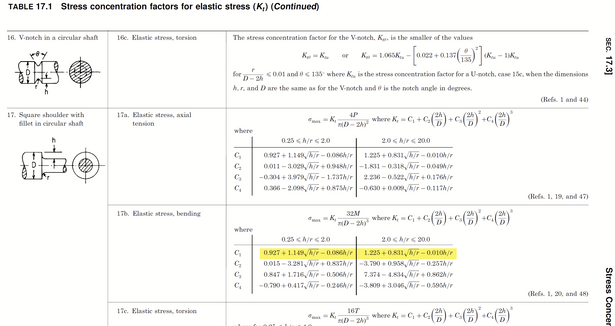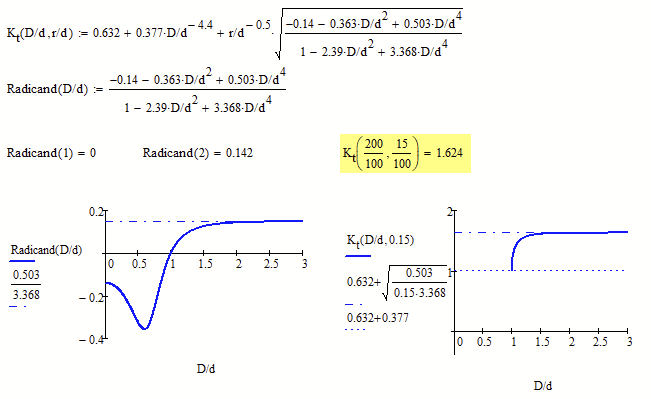Community Tip - Have a PTC product question you need answered fast? Chances are someone has asked it before. Learn about the community search. X
- Subscribe to RSS Feed
- Mark Topic as New
- Mark Topic as Read
- Float this Topic for Current User
- Bookmark
- Subscribe
- Mute
- Printer Friendly Page
roarks ebook 6th edition: constant for case 17b correct?
- Mark as New
- Bookmark
- Subscribe
- Mute
- Subscribe to RSS Feed
- Permalink
- Notify Moderator
roarks ebook 6th edition: constant for case 17b correct?
To all
In mcad Roark's e-book 6th edition there is a worksheet to calculate the stress concentration (case 17b).
I just noted that the constants to calculate the values for C1, etc are different to the ones in the latest book (Petersons 3rd edition)
1. Am I correct?
2. I cannot find a 1974 copy 1st edition (I guess!) which appear to be the reference used. Has anyone got access and could confirm?
3. Is it the same in the latest ebook which I think is based on Roark's 7th edition but as far as I can tell in the printed Roark's 7th edition the numbers are from the 1974 edition too
Thanks
Regards
- Labels:
-
Mechanical_Engineering
- Mark as New
- Bookmark
- Subscribe
- Mute
- Subscribe to RSS Feed
- Permalink
- Notify Moderator
My printed 4th edition doesn't have a case 17 . . . (jumps from 16 to 18, ???)
My previous experience with the Roark ebook (under the original Mathcad owners) was that it had been farmed out to an intern as a project so they could improve their Mathcad skills; the information was (mostly) correct but the programming was stilted, plots were usually vectors not functions even though functions were used to calculate the vector values.
Given your choices I would choose (in preference order):
- Peterson
- Printed Roark
- your best guess
- Roark ebook.
If you post your problem geometry (not just a table reference) I'll try to help further.
Good Luck!
- Mark as New
- Bookmark
- Subscribe
- Mute
- Subscribe to RSS Feed
- Permalink
- Notify Moderator
Thanks. I set-up the Kt calc as per Petersons 3rd edition and for my geometry I got 2.65. the formula in Roark's ebook gave me 2.64. So not going to lose sleep
The geo is irrelevant (but thanks for the offer) I am more concerned about the factors and the discrepancy
- Mark as New
- Bookmark
- Subscribe
- Mute
- Subscribe to RSS Feed
- Permalink
- Notify Moderator
Not my area of expertise at all, but the table in the seventh edition I found here
seems to correspond with the formula in the Mathcad sheet:
- Mark as New
- Bookmark
- Subscribe
- Mute
- Subscribe to RSS Feed
- Permalink
- Notify Moderator
but as fas as I can see the constants in the calculation of the C values are not the one in Peterson 3rd edition
- Mark as New
- Bookmark
- Subscribe
- Mute
- Subscribe to RSS Feed
- Permalink
- Notify Moderator
- Mark as New
- Bookmark
- Subscribe
- Mute
- Subscribe to RSS Feed
- Permalink
- Notify Moderator
You may consider creating a variable name like "h/r"
- Mark as New
- Bookmark
- Subscribe
- Mute
- Subscribe to RSS Feed
- Permalink
- Notify Moderator
😊
Yeah, I was in a rush, I don't think cntrl-shift-K works in Prime, so I'd have to type it in text, copy it, then paste it everywhere I needed it. so h_r is type-able. (Remember--I'm a lazy engineer!)
BTW, isn't it strange how the C's change so abruptly between regions? (Except for the first!)
- Mark as New
- Bookmark
- Subscribe
- Mute
- Subscribe to RSS Feed
- Permalink
- Notify Moderator
BTW, isn't it strange how the C's change so abruptly between regions? (Except for the first!)
I am too far out of my comfort zone - even to make an educated guess. But at least I can say that its remarkable.
Empirical formulas ofton follow their own intrinsic logic and as along as we don't know how exactly they were arrived at ...
But i think that the values of the various C's are not that critical - but I would expect the cubic K.t to be nice and smooth without obvious crincles. But then, I may be wrong.
- Mark as New
- Bookmark
- Subscribe
- Mute
- Subscribe to RSS Feed
- Permalink
- Notify Moderator
Empirical formulas often follow their own intrinsic logic and as along as we don't know how exactly they were arrived at ...
But i think that the values of the various C's are not that critical - but I would expect the cubic K.t to be nice and smooth without obvious crincles. But then, I may be wrong.
You're not wrong:
- Mark as New
- Bookmark
- Subscribe
- Mute
- Subscribe to RSS Feed
- Permalink
- Notify Moderator
7th Edition:
8th Edition:
P.S. Years of edition (from 9-th to 1-st): 2020, 2012, 2002, 1989, 1975, 1965, 1954, 1943, 1938.
- Mark as New
- Bookmark
- Subscribe
- Mute
- Subscribe to RSS Feed
- Permalink
- Notify Moderator
as per the original poster question I had a look at my copy of Petersons and indeed it seems that the constants defined in the C values are different - see attached Chart 3.10 from Peterson
The Roark's data seems to be pointing to the 1st edition of Peterson
@JXBWk The difference appears to be academic in this case - see graph attached (an "issue" at t/r = 2.0 possibly but I may have a made a mistake in typing the numbers!) but I get your point. One difference also is that the 1st set of C values are for 0.1 <= t/r <= 2.0 where in Roark's it is for 0.25 <=t/r<= 2.0
- Mark as New
- Bookmark
- Subscribe
- Mute
- Subscribe to RSS Feed
- Permalink
- Notify Moderator
Peterson's also gives an equation for Kt bending, eq 3.7 - taken from Tipton et All (see attached), but if I "code" it get an imaginary number out of it !!
Tried with D = 200, d=100, r15 and I get 0.65+0.479i
Obviously does make sense - What I am doing wrong?
- Mark as New
- Bookmark
- Subscribe
- Mute
- Subscribe to RSS Feed
- Permalink
- Notify Moderator
@JXBWk wrote:
Peterson's also gives an equation for Kt bending, eq 3.7 - taken from Tipton et All (see attached), but if I "code" it get an imaginary number out of it !!
Tried with D = 200, d=100, r15 and I get 0.65+0.479i
Obviously does make sense - What I am doing wrong?
How could we tell if you don't show what you did?
My best guess is that you typed 0.503*(d/D)^4 instead of 0.503*(D/d)^4.
The formula gives you real values as long as |d/D| is greater or equal to 1 and in your case D/d=2, so all seems to be OK.
- Mark as New
- Bookmark
- Subscribe
- Mute
- Subscribe to RSS Feed
- Permalink
- Notify Moderator
Fair enough - Was still thinking about what I was writing in mcad when I asked the questing. Must have overlooked as I did attach the equation!
- Mark as New
- Bookmark
- Subscribe
- Mute
- Subscribe to RSS Feed
- Permalink
- Notify Moderator
@JXBWk wrote:
Fair enough - Was still thinking about what I was writing in mcad when I asked the questing. Must have overlooked as I did attach the equation!
Wow! Looks like my freshly polished crystal ball did a good job 😉
- Mark as New
- Bookmark
- Subscribe
- Mute
- Subscribe to RSS Feed
- Permalink
- Notify Moderator
Hmmm!
File of original Kt with your equation appended (Prime 4) attached.
- Mark as New
- Bookmark
- Subscribe
- Mute
- Subscribe to RSS Feed
- Permalink
- Notify Moderator
Clearly I am an idiot who cannot make the difference between D/d and d/D !
I typed 0.503(d/D)^4 instead of 0.503(D/d)^4














